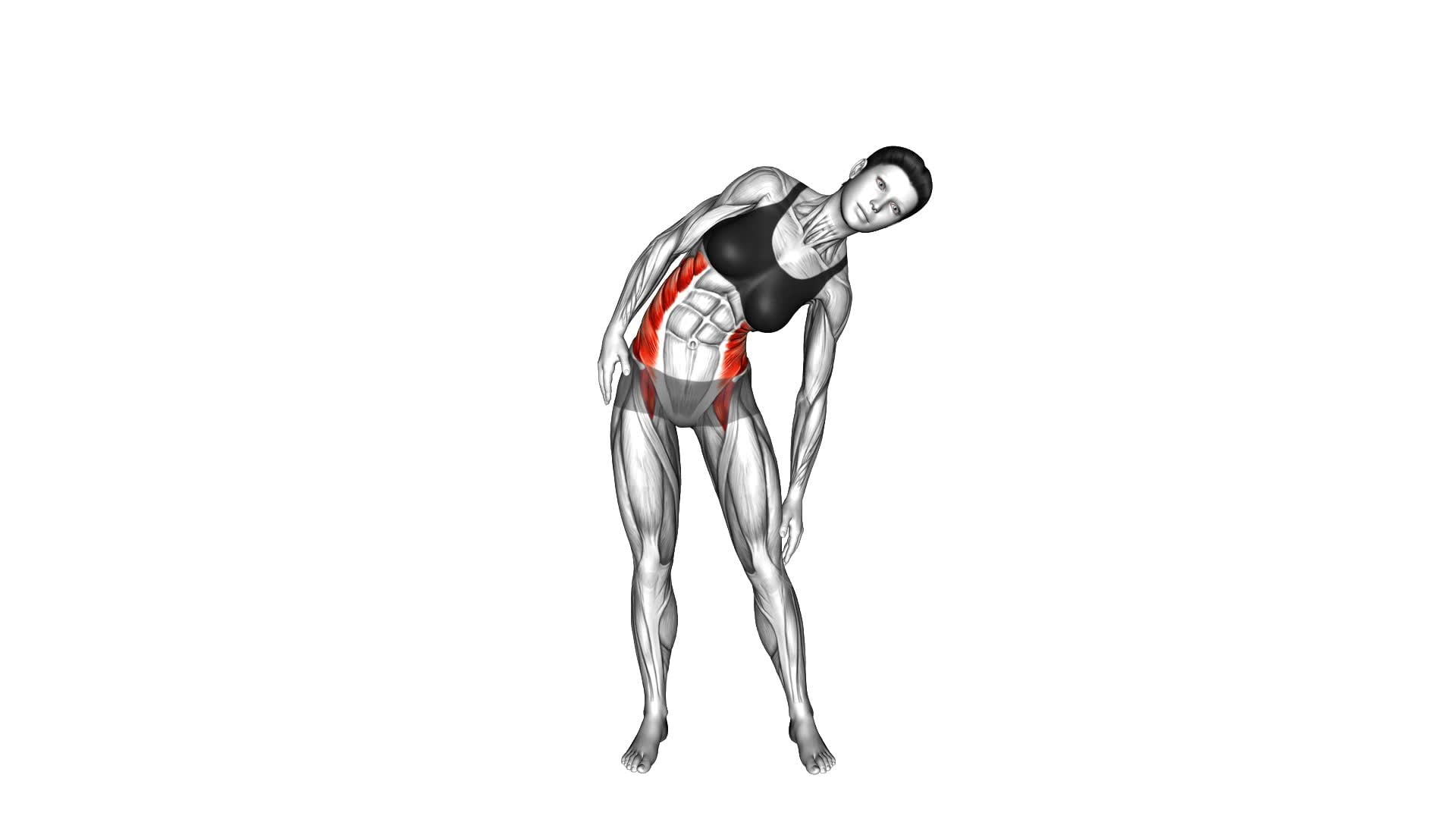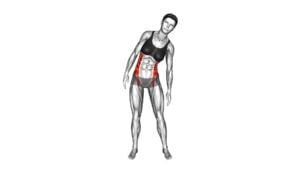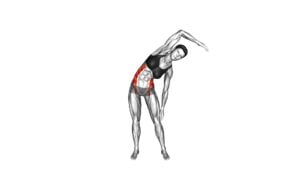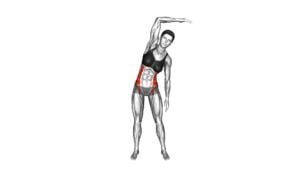Standing Side Bend (female) – Video Exercise Guide & Tips

You can strengthen and stretch your core muscles with the Standing Side Bend exercise. This video exercise guide and tips will show you the proper technique to follow. Avoid common mistakes and maximize the effectiveness of the exercise with helpful tips.
Watch This Exercise Video
Whether you're a beginner or advanced, there are modifications and progressions for all fitness levels. Get ready to feel the burn and improve your overall flexibility and stability.
Let's get started!
Key Takeaways
- The Standing Side Bend improves core strength and flexibility.
- It targets muscles in the abdomen, back, and obliques.
- It enhances posture and increases flexibility and range of motion in the torso.
- It engages muscles that support the spine for stability and alignment.
Benefits of the Standing Side Bend
One of the main benefits of the Standing Side Bend is that it helps you improve core strength and flexibility. By incorporating this exercise into your routine, you can work on strengthening the muscles in your abdomen, back, and obliques, which in turn can lead to improved posture. The Standing Side Bend also targets your side muscles, increasing flexibility and range of motion in your torso. This exercise specifically engages the muscles that support your spine, providing stability and helping you maintain proper alignment throughout the day.
In addition to improved posture, the Standing Side Bend also helps to increase flexibility. As you perform the exercise, you stretch and lengthen the muscles along the sides of your body, including your obliques, lats, and intercostal muscles. This increased flexibility can enhance your overall physical performance, as well as reduce the risk of injury during other activities or exercises.
Now that you understand the benefits of the Standing Side Bend, let's move on to discussing the proper technique for performing this exercise.
Proper Technique for the Standing Side Bend
To perform the Standing Side Bend exercise correctly, follow these steps:
- Stand with your feet shoulder-width apart and your arms extended overhead.
- Engage your core muscles and maintain a tall posture throughout the movement.
Here are some key tips to ensure proper technique:
- Initiate the movement by gently bending your upper body to the side, focusing on the stretch along the entire length of your oblique muscles.
- Avoid leaning forward or backward, and keep your hips stable and aligned with your feet.
- Control the movement as you return to the starting position, using your oblique muscles to resist gravity.
- Maintain a smooth and fluid motion, without any jerking or bouncing.
- As you perform the exercise, remember to breathe deeply, inhaling as you bend to the side and exhaling as you return to the starting position.
Variations of the Standing Side Bend can be performed by using dumbbells or a resistance band to add resistance or by incorporating a twist at the end of the movement to target the obliques from a different angle. Experimenting with different variations can help you keep your workout interesting and challenge your muscles in new ways.
Common Mistakes to Avoid
Avoiding common mistakes is crucial when performing the Standing Side Bend exercise. By being mindful of these errors, you can prevent injuries and enhance your flexibility. One common mistake is hunching your shoulders during the exercise. This not only reduces the effectiveness of the stretch but also puts unnecessary strain on your neck and upper back. To avoid this, keep your shoulders relaxed and down, allowing the movement to come from your side muscles.
Another error to avoid is overextending or bending too far to the side. This can lead to muscle strains or even injuries. Instead, focus on maintaining a controlled and gentle movement, only going as far as is comfortable for you.
Lastly, avoid rushing through the exercise. Take your time and hold the stretch for a few seconds on each side to maximize its benefits. By being mindful of these common mistakes, you can ensure a safe and effective Standing Side Bend workout.
Now that you're aware of the common mistakes to avoid, let's move on to some tips for maximizing the effectiveness of the exercise.
Tips for Maximizing the Effectiveness of the Exercise
To maximize the effectiveness of the Standing Side Bend exercise, use proper form and engage your core muscles. Here are some tips to help you get the most out of this exercise:
- Breathe: Remember to breathe deeply and exhale as you bend to the side. This will help you engage your core and maintain stability throughout the movement.
- Focus on the side muscles: While performing the exercise, concentrate on the muscles on the side of your body that you're bending towards. This will help you target and strengthen those specific muscles.
- Avoid leaning forward or backward: Keep your upper body straight and avoid leaning forward or backward during the movement. This will ensure that you're working the correct muscles and avoid any strain on your back.
- Start with lighter weights: If you're using weights for added resistance, start with lighter weights and gradually increase the intensity as you become more comfortable and confident with the exercise.
- No equipment needed: This exercise can be done without any equipment. However, if you want to add more resistance, you can use dumbbells or a resistance band.
Modifications and Progressions for All Fitness Levels
As you progress in your fitness journey, there are various modifications and progressions that can be implemented to accommodate all levels of fitness in the Standing Side Bend exercise.
For beginners or individuals with limited flexibility, you can start by performing the exercise with a smaller range of motion. Instead of reaching your hand all the way down to your knee, you can start by reaching towards your thigh or hip. This modification allows you to gradually increase the intensity of the exercise as your flexibility improves.
To further challenge yourself and progress in the exercise, you can add resistance by holding a dumbbell or kettlebell in your hand while performing the side bend. This added weight will engage your muscles even more and provide a greater challenge for your core and obliques.
Another progression for more advanced individuals is to perform the exercise on an unstable surface such as a stability ball or BOSU ball. This forces your muscles to work harder to maintain balance and stability throughout the movement.
Remember to listen to your body and only progress to more challenging modifications when you feel comfortable and confident in your current level of fitness. Always consult with a qualified fitness professional if you have any concerns or questions about the modifications and progressions in the Standing Side Bend exercise.
Frequently Asked Questions
Can the Standing Side Bend Exercise Help Reduce Waistline Fat?
The standing side bend exercise can definitely help reduce waistline fat. By engaging the muscles in your obliques, the standing side bend promotes toning and strengthening of the waistline area. This exercise targets the love handles and can contribute to a more defined waist.
Adding this exercise to your routine, along with a healthy diet, can lead to noticeable waistline fat reduction.
Is It Necessary to Use Weights While Performing the Standing Side Bend?
When performing the standing side bend, you may wonder if it's necessary to use weights. Incorporating resistance into this exercise can provide additional benefits.
Using weights adds resistance, which challenges your muscles and helps to strengthen and tone them. This can lead to increased muscle definition and a more effective workout.
However, if you prefer a non-weighted option, you can still benefit from the standing side bend by focusing on proper form and engaging your core muscles.
Can the Standing Side Bend Exercise Be Done by Individuals With Lower Back Pain?
Yes, the standing side bend exercise can be done by individuals with lower back pain. However, it's important to modify the exercise to avoid exacerbating the pain. Instead of using weights, focus on performing the movement with proper form and control.
Additionally, there are alternative exercises that can provide lower back pain relief, such as gentle stretches, pelvic tilts, and cat-cow poses.
Consult with a healthcare professional or a qualified fitness instructor for personalized guidance.
How Long Should One Hold the Stretch During the Standing Side Bend Exercise?
To get the most out of the standing side bend exercise, it's important to know how long to hold the stretch. Holding the stretch for about 20-30 seconds is a good starting point.
This will help to reduce waistline fat and improve posture. Remember to listen to your body and adjust the duration based on your comfort level.
As you become more flexible and comfortable with the exercise, you can gradually increase the hold time for even better results.
Can the Standing Side Bend Exercise Help Improve Posture?
The standing side bend exercise can help improve your posture by strengthening your core muscles. By engaging your core while performing the exercise, you can develop better alignment and stability in your spine.
To do the exercise properly, stand with your feet shoulder-width apart, place one hand on your hip, and reach the opposite arm overhead and to the side. Keep your body in a straight line as you bend sideways, focusing on lengthening through your side.
Conclusion
In conclusion, the standing side bend is a beneficial exercise for improving flexibility and strengthening the core muscles. By maintaining proper technique and avoiding common mistakes, you can maximize the effectiveness of this exercise.
Additionally, modifications and progressions are available to accommodate all fitness levels. Incorporate the standing side bend into your fitness routine to enhance your overall physical well-being.

Author
Years ago, the spark of my life’s passion ignited in my mind the moment I stepped into the local gym for the first time. The inaugural bead of perspiration, the initial endeavor, the very first surge of endorphins, and a sense of pride that washed over me post-workout marked the beginning of my deep-seated interest in strength sports, fitness, and sports nutrition. This very curiosity blossomed rapidly into a profound fascination, propelling me to earn a Master’s degree in Physical Education from the Academy of Physical Education in Krakow, followed by a Sports Manager diploma from the Jagiellonian University. My journey of growth led me to gain more specialized qualifications, such as being a certified personal trainer with a focus on sports dietetics, a lifeguard, and an instructor for wellness and corrective gymnastics. Theoretical knowledge paired seamlessly with practical experience, reinforcing my belief that the transformation of individuals under my guidance was also a reflection of my personal growth. This belief holds true even today. Each day, I strive to push the boundaries and explore new realms. These realms gently elevate me to greater heights. The unique combination of passion for my field and the continuous quest for growth fuels my drive to break new ground.







